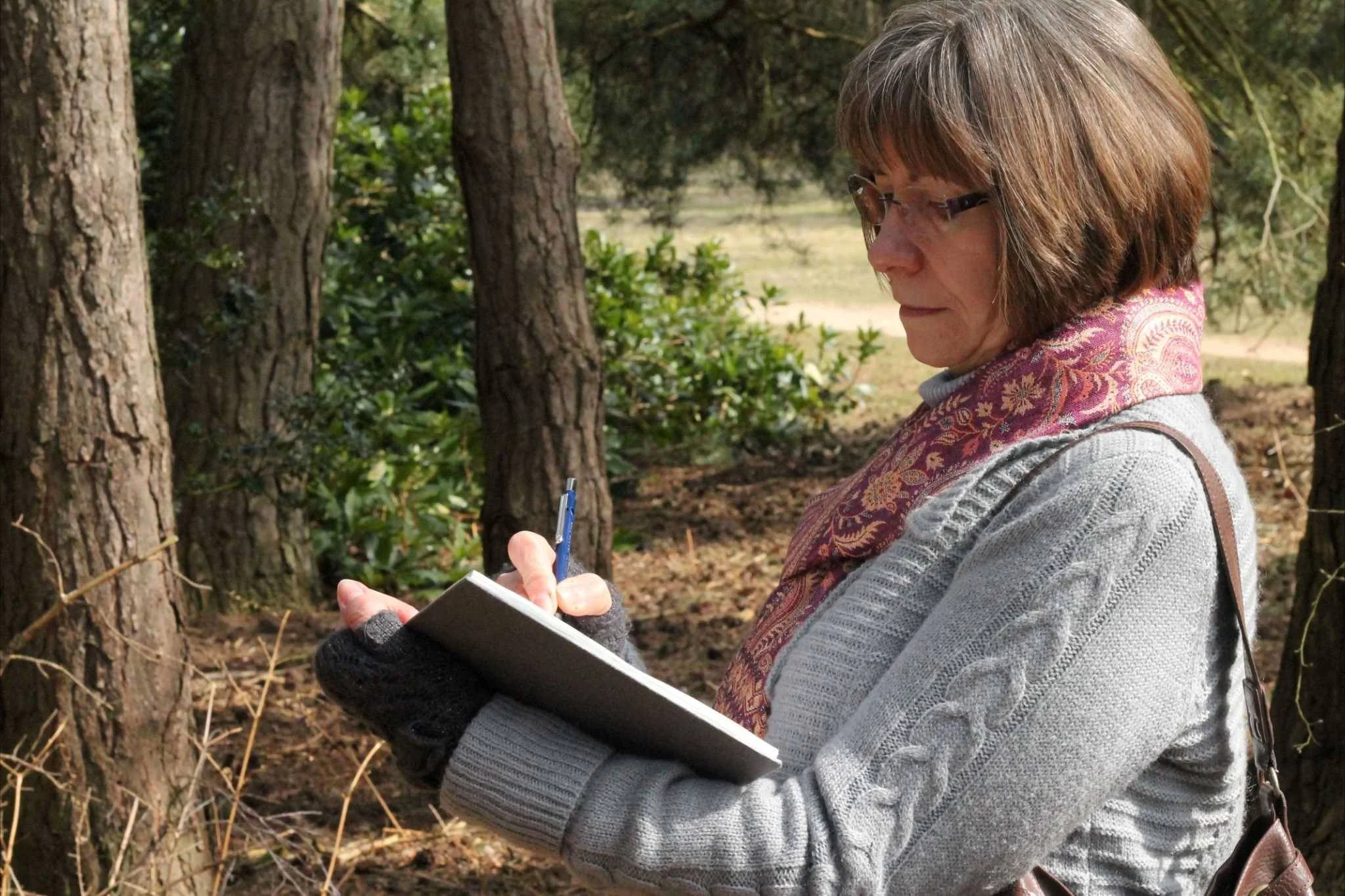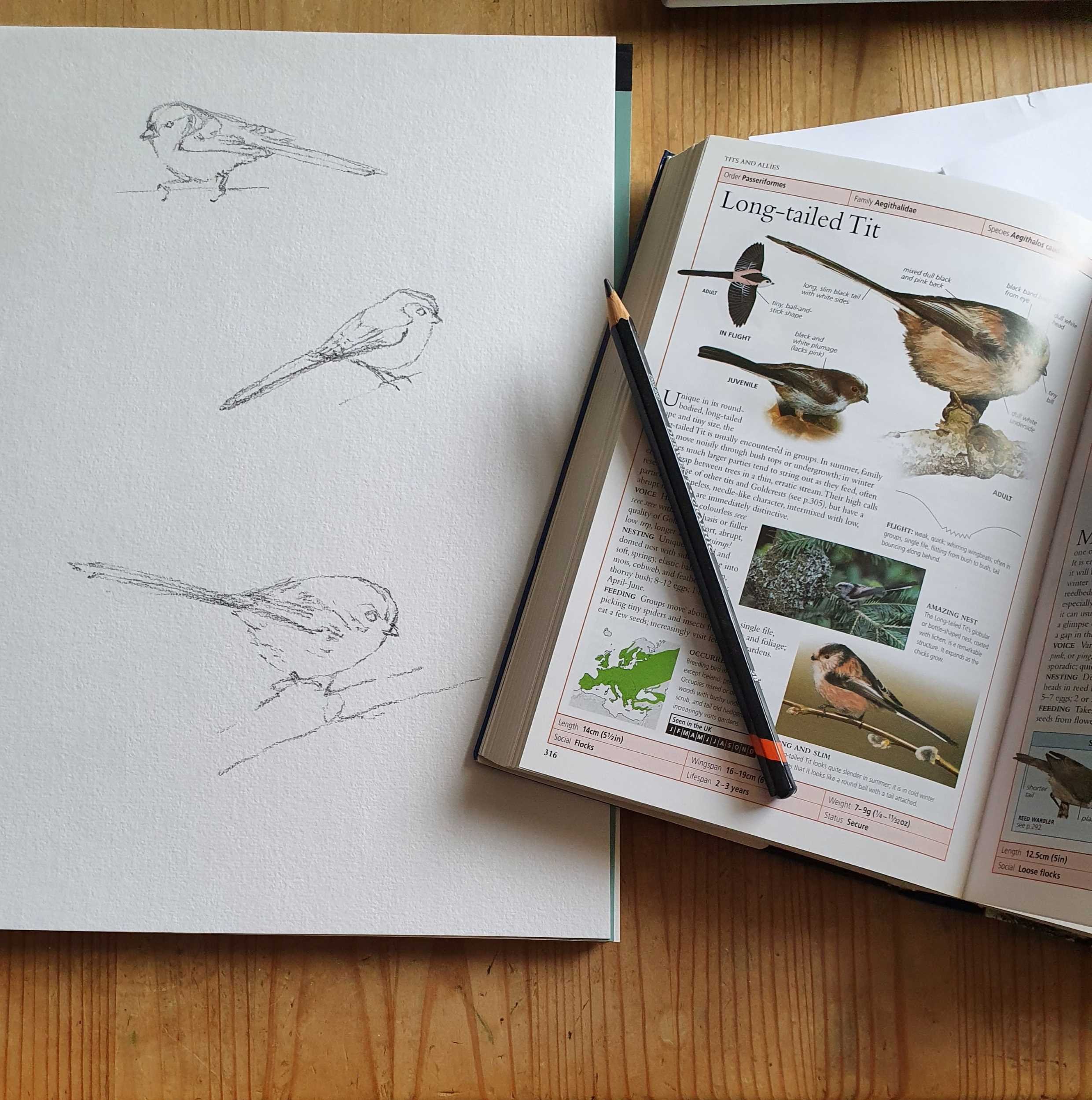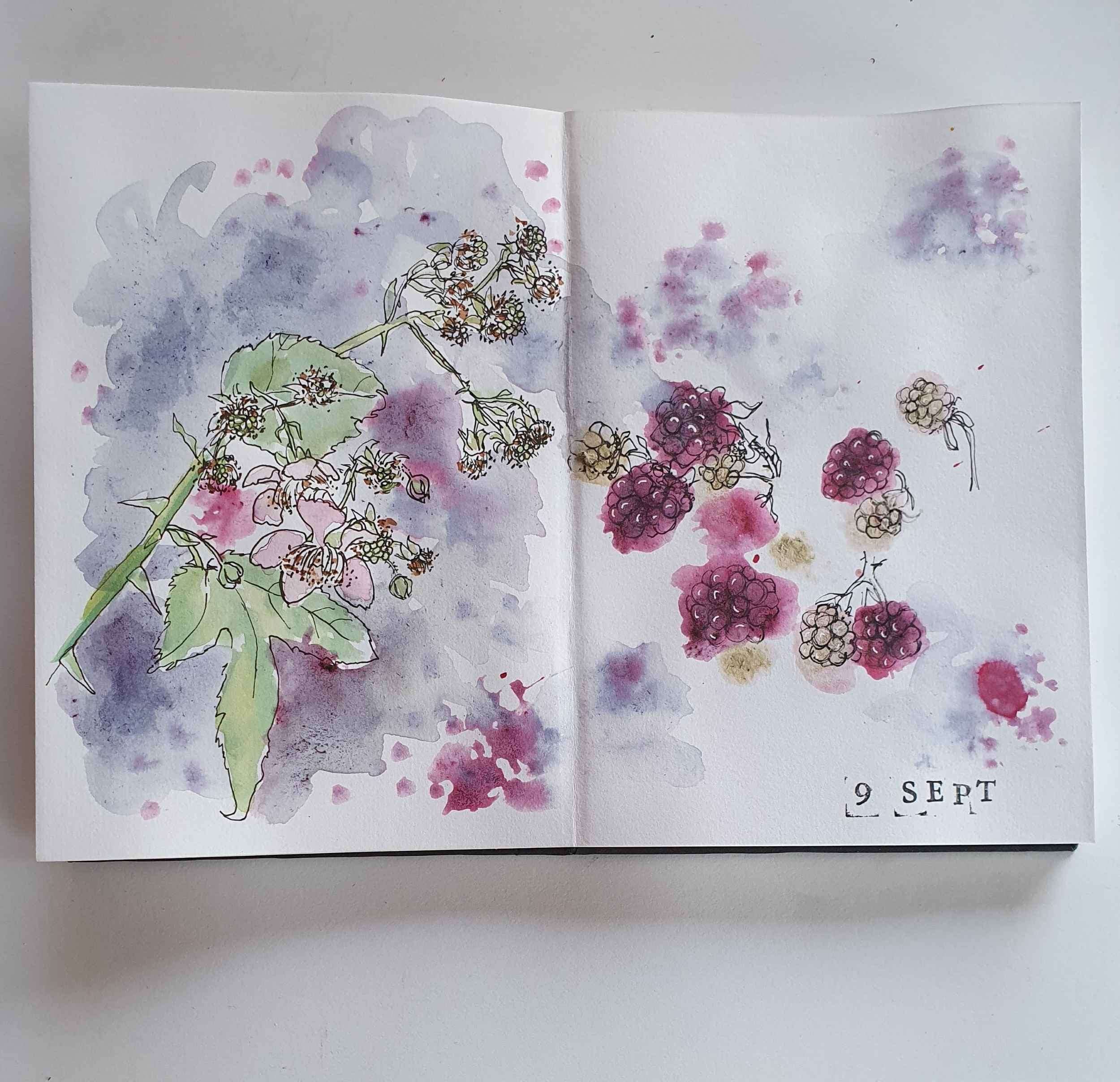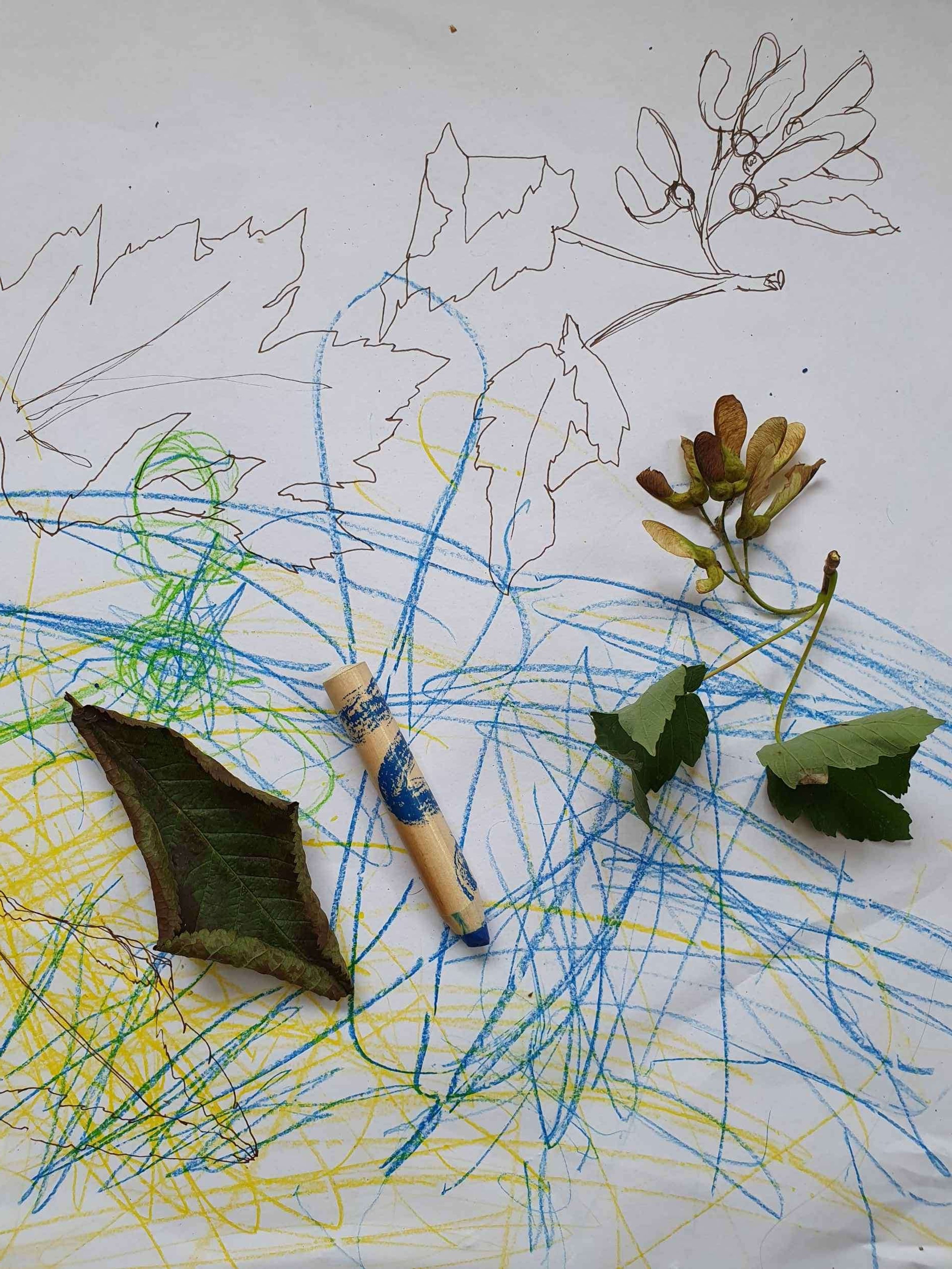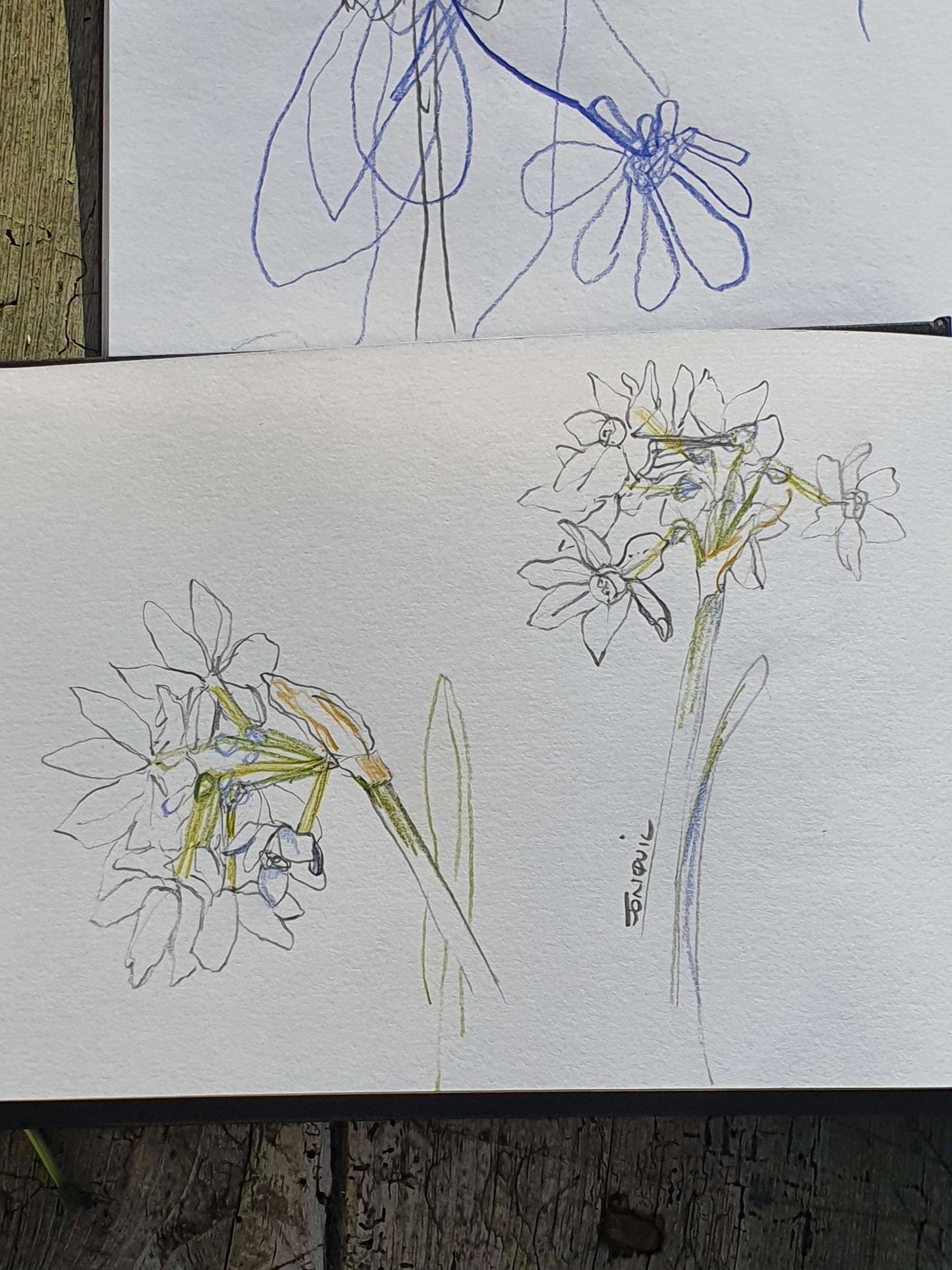My initial thoughts about nature journaling were probably typical… a notebook or sketchbook filled with drawings and jottings about flora and fauna, neatly labelled, dated and symbols indicating weather conditions. Thanks to initiatives like International Nature Journaling Week and the word ‘greensketching’ coming to the fore as, post-pandemic, we all become more aware of the benefits whilst connecting with nature, I now have a much broader view of what nature journaling can be.
I am coming to nature journaling as an artist who loves experimenting with a variety of art materials. I create work that veers from reasonably accurate to messy and sometimes abstracted. Working directly from nature I find great pleasure in drawing the plants in my garden and our three-quarter acre field beyond. I enjoy focusing on the shapes, relating one aspect to another, the negative shapes, textures, details, colour, and then how to capture some of this through drawing.
Let’s look at a few pages and introduce some ideas you might find interesting and like to try…
Simple Line Drawings (Daffodil)
A double page spread. In one hand a humble graphite pencil and in the other a bright yellow daffodil. The pencil lines are a little hesitant, stop and start, exploring the shapes of the trumpet and open petals. Double check, how many petals? I add some shading with hatched lines, and a few details. A flower still closed catches my eye, the papery bract evident, and that joins the page. Pausing, the ‘tightness’ of the drawing encourage me to go on… I want daffodils that express more looseness, that say something about the joyfulness of this Spring flower. I scribble across the middle of the sketchbook lightly with yellow and green water mixable crayons. A swish of water and the pigments dissolve. Once dry, more lines in pencil to describe the flowers. I work quickly and, now familiar with the shapes, this creates more energy. There is a slight calligraphic quality as I increase or decrease the pressure on the pencil mark. A few more buds cluster onto the opposite page. Another change in angle for a final flower, sketchy and with a little shading. I stop, happy to have a drawn record of these daffodils on the Meteorological First Day of Spring.
Art Tips:
1. Add colour to the page before drawing and create another layer of interest.
2. Hold the pencil further away from the tip and try changing the speed you make marks and lines – how does it change the quality? Which do you prefer?
Simple Layered Drawings (Dog Rose)
It is warm and sunny. I am sitting in my little field on a fold up stool, an A3 board on my lap. It is June 2020 and the very first International Nature journaling Week! An A3 sheet of cartridge paper has been folded into a concertina. I have cut a sprig of Dog Rose, a wild hedge plant that scrambles through the trees and bushes of the old hedge line. It is a magnificent sight every year. The sun is on my back and casts strong shadows on the white paper. Grabbing a pencil I trace around those plant shadows, changing the angle of the flower and leaves periodically. Sometimes the shadows are strangely elongated or the tracing very odd as the gentle breeze alters the shadow positions.
I have my watercolour paintbox nearby and a waterbrush. Ignoring the initial drawing I create simple washes of colour in the shape of the flower petals and leaves directly over the top. The final result could be seen as a bit of a mess by some, but I am satisfied. Overlapping the two simple stages has formed a more complex web of lines and colours than in isolation. For me, it conveys the habit of this Dog Rose, how it uses other structures to clamber through on its spreading journey.
Art Tips:
1. Try shadow drawing. No expectations as to how it will look. If there’s a breeze either pause until the shadows resume their place or let your pencil dance and follow!
2. Change media and draw further views of your subject on the top. Ignore what is beneath, let both layers have their own identity.
Long-tailed Tits
I spend lots of time watching the bird life in my garden. Pheasant strut onto the patio, rooks caw overhead and in the tree tops noisily, green woodpeckers stab their beaks into the ground hunting for ants and many garden species enjoy the bird feeders. Long-tailed Tits are among my favourites. In big family groups they cluster together amicably on the feeders in the lilac tree, and then they are off. Such a fleeting glimpse. I have moved out of the sketchbook onto an A4 sheet of watercolour paper. A bird book is open and I read more about the characteristics and habitat. I study the photo illustrations, my own photos too blurry or distant to be much use. I sketch 3 little birds in pencil, just studies, not a full composition.
Using a big paintbrush I sweep burnt sienna and Payne’s grey watercolour onto the birds and beyond. On impulse, whilst still wet, I grab a peg and dash outdoors to the feeders and peg the page to a twig. It is very windy, the page flaps about wildly. The paint drips down with gravity and wind action. I encourage this further by spattering on more water with my brush. It feels elemental and crazy and I am delighted to see my drawn birds flapping in the lilac tree where earlier, I had watched a flock of these little beauties.
Art Tips:
How could you interact more with the elements? Let the wind push wet paint over the page. Let falling raindrops react with water soluble media. Let frost form ice crystals in watercolour.
Blackberry Season
Early September, the field is edged with blackberries. My young grandson is visiting with my daughter. We wander up the field in the sunshine, picking blackberries… some in the pot, some we eat and savour fresh off the bramble bushes. I bring a sprig back with me to the patio table. Inspiration strikes, “Who would like to squash blackberries?” I quickly gather sketchbooks, pens, pencils and spread them on the table. My grandson watches with surprise as I squash some of the juicy fruits onto my paper and needs no encouragement to try the same on his pages! Even my daughter can’t resist this playful approach. We spend a happy hour squashing blackberries, drawing and chatting. I add a pen drawing on the facing page and use water to spread out some of the juices.
I do some penwork to describe the little lobes of each fruit over the main blobs of dried juice and highlights are added with a white gel pen. Blackberries are fun to squash, draw and delicious to eat!
Art Tips:
How can you incorporate some natural colour into your journal pages? Squash and rub flowers/leaves/berries if they are in your garden or abundant in the wild. Tap pollen from flowers or catkins and press or smear to stain the paper. Maybe try your hand at making natural botanical inks?
Pat, Present and Future
For many years I taught adult art classes and gradually my interest became focused on drawing the natural world. As adults we can have a lot of expectations and insecurities about creativity and I have always been passionate in my encouragement of experimentation, playfulness and enjoyment of the process rather than the final outcome. As I look at my grandson, who turns 4 in September, and watch his intuitive in-the-moment approach to creative activities I am full of admiration. Contemplating the future I hope I will have many years out in nature with my grandchildren, sketchbooks in hand – experimenting, playing and chatting about our discoveries.
Whatever your style of nature journaling, whatever your level of experience, I do hope you have found something of interest in my approaches. Why not unleash your inner child and experiment a little?
About Tod
Tod Evans is a versatile artist and very much inspired by the natural world. She happily works with pencils, charcoal, pens, inks, watercolour, acrylics and pastels – often combining several media when exploring the potential of an idea. Her artwork currently focuses on developing more expressive personal mark-making and can be described as ‘lively’, with fusions of colour including dribbles and spatter, often overlaid with calligraphic strokes of brushwork, pastels or inks.

